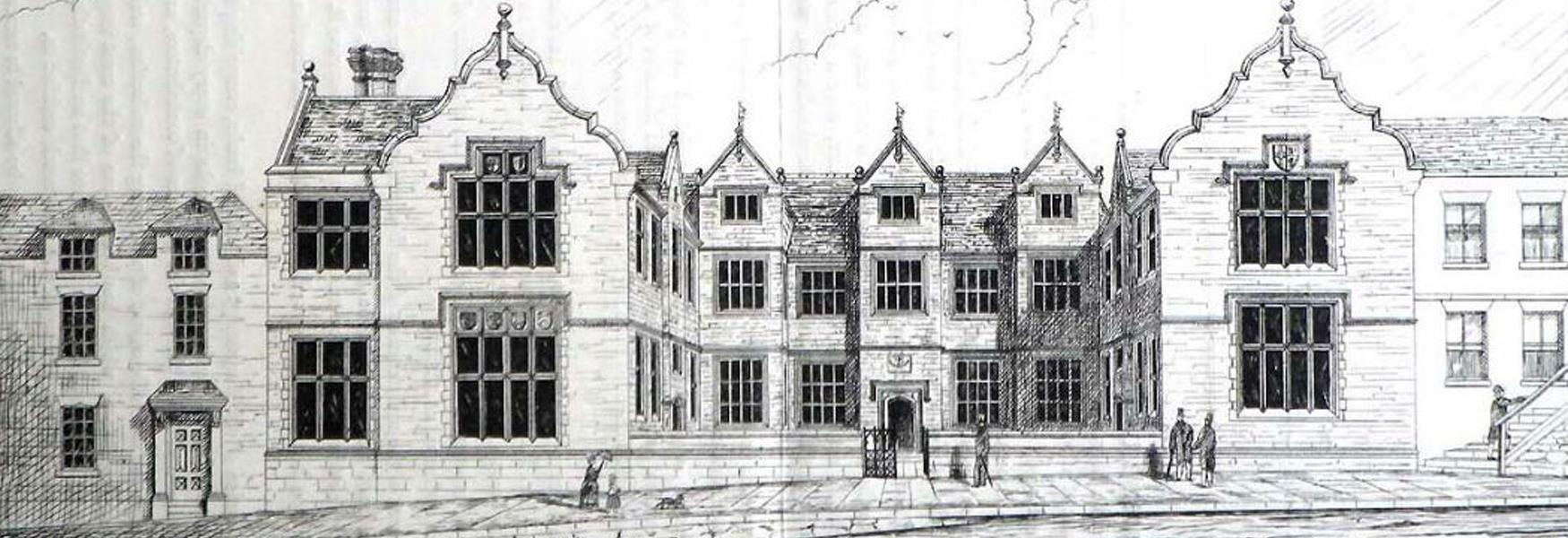To build your own Itinerary, click  to add an item to your Itinerary basket.
to add an item to your Itinerary basket.
Already saved an Itinerary?


You are here: Things to Do > Tours and Trails > Maidstone's Historic Walking Tour
In Maidstone, there are centuries of history waiting to be discovered, you just need to know where to look. Follow this short walking tour to discover more about the hidden history of Maidstone, Kent’s County Town. There are also a number of historic panels along the route offering more details. Your walk starts from the Visitor Information Centre located at Maidstone Museum in St Faith’s Street.
Largely housed in Chillington Manor, Maidstone Museum is one of the most interesting old buildings in the town and a fine example of domestic architecture from the late Tudor period. The core of the present house was built between 1561 and 1577 for local MP Nicolas Barham. In 1855 the Manor’s then owner bequeathed his collection of antiquarian objects to the town, which purchased his house and opened a museum to the public in January 1858. Chillington Manor was then extended to provide purpose-built galleries to house the collections of Maidstone’s many Victorian benefactors. The most recent addition is the new East Wing, which was completed in 2012. Entrance to the museum is free.
Exit the museum and walk down towards the river a short way, you will find an historic panel giving more details about the building and its benefactors. Now head back up St Faith’s Street


Visit Kent's only Egyptian Mummy, Tarkesh, at Maidstone Museum.
Opposite the entrance to the Museum is a row of Georgian almshouses. These were donated in 1700 by Sir John Banks, who lived at The Priory in Aylesford. The almshouses are still occupied today under special licence.
Enter Brenchley Gardens.
Formerly the grounds of Chillington Manor, these quiet municipal gardens were opened in 1871 as Maidstone’s first public park. The War Memorial was designed by Sir Edwin Lutyens, who also designed the Cenotaph in London, amongst his many other works.
Head through the park taking the footpath around the bandstand. Exit onto Station Road then cross Week Street into Sessions Square.
Sessions Square is dominated by the neo-Baroque façade of County Hall which was built 1910 - 1913, with further extensions in the 1930s. Behind it, and glimpsed through the arch, is the original Sessions House dating from 1826-7. Maidstone Prison is located behind Sessions House, and more details on this area can be found on the historic panel in the Square.
Continue along Week Street.
Week Street lies along the line of a Roman road linking Rochester with the ironworking areas of the Weald and the port of Lympne. Foundations of a Roman building were found here in the 1960s. The street also provides some notable examples of pargetted houses (no’s 55-57), which date back to 1680. Pargetting, a term describing the use of external lime plaster in a decorative manner, became common when the wattle and daub of the half-timbered Tudor houses began to fall into decay.
Discover more about Roman Maidstone on the historic panel outside Clark’s Shoe Shop. Then take the turning into Earl Street.
So named after Earl’s Place, a major medieval town house with grounds that once occupied the whole area. A double-fronted town house (no’s 31-33) was owned by Andrew Broughton, Mayor of Maidstone (1648). Broughton was Clerk to the High Court and signed the death warrant of King Charles I in 1659.In 1869, a concert hall was erected in Earl Street. Known today as the Hazlitt Theatre, after William Hazlitt who was born in nearby Rose Yard. Today, William is renowned as the first major drama critic in English. A little further down the street, no. 32 was constructed in 1882 as the Conservative Club and features over its entrance the carved head of Benjamin Disraeli, once MP for Maidstone.
Turn into Market Buildings.
From at least the year 1261 until the 1820s, the High Street was the original market-place of Maidstone. New market buildings were erected in 1825 and, in 1835, a new Corn Exchange was built.
Stop at the historic panel on the right hand side as you enter Market Buildings. Then turn right into the entrance to Royal Star Arcade.
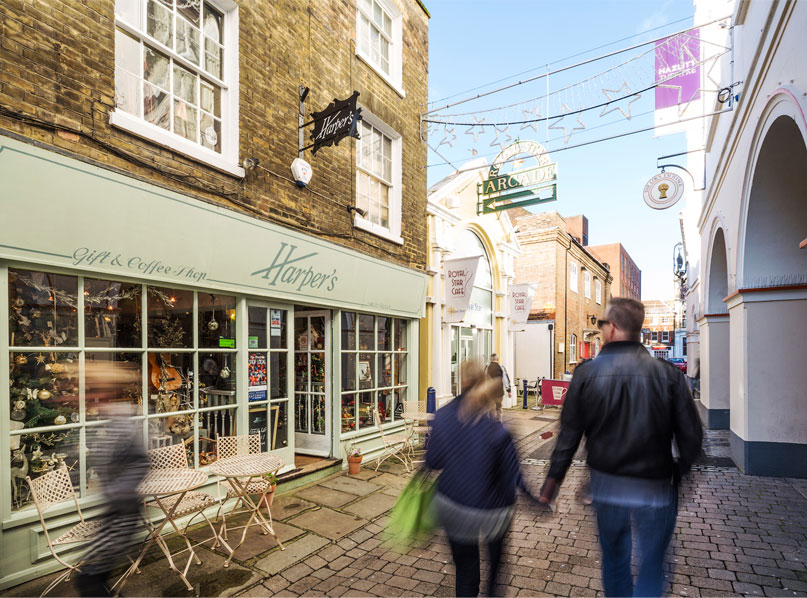
Now an exclusive shopping arcade, the Royal Star was once Maidstone’s leading hotel, frequented by the gentry during the town’s Georgian heyday. Princess Victoria stayed here in 1836. The following year, on winning his first seat in Parliament as the town’s MP, Benjamin Disraeli addressed the electors from the hotel’s balcony overlooking the Town Hall on the High Street.
Walk through the arcade then turn right towards the Lower High Street.
On 28th January 1554 Sir Thomas Wyatt rode into the High Street and called on the men of Kent to aid him in preventing Queen Mary’s marriage to Philip of Spain. He found ten thousand men ready to protest, but like previous Kentish uprisings, the revolt failed, Wyatt was executed and Maidstone lost its Royal Charter. The Russian Gun, ‘the Cannon’, was captured in battle during the Crimean War and was presented to the town in 1858 by Lord Pamure, the Secretary of War.
Turn around and head up Bank Street.
Bank Street was formed by the encroachment of properties in Middle Row into the former broad market-place. It is probably the most complete historical street in Maidstone and most of the buildings in it are listed for their architectural or historical interest. Many shops here date from the 15th to 17th centuries and can still be recognised by their overhanging upper floors, a feature known as jettying. Notice four white statues set into niches in the first floor above no’s 89-90. From left to right these are: Lord Avebury; Sir Lawrence Washington; William Caxton and Archbishop Courtenay.
No. 73 has a flamboyant Queen Anne style shop front, while the gilt crossed guns at no. 85 are a 19th century trade sign. The Brenchley was built in 1927 by F.C. Palmer and is an excellent example of a Georgian Bank, being originally home to the NatWest & Kentish banks, and features a fine domed interior. Bank Street was also the location of a distinctive industry - gin distillation. By 1809, the Bank Street distillery was the town’s largest manufactory producing 5,000 gallons a week by 1818.
A fine Georgian building dating from 1763, the Town Hall served many purposes, as market space, magistrate’s court, council chambers and gaol. The gaol was located in the loft and can still be visited today; its walls covered in 18th century graffiti. The statue of a young Queen Victoria in Jubilee Square dates from 1862 and stands on the site of the ancient market cross.
Discover more about this area’s role as a market place on the historic panel located just to the side of the Town Hall (at the top of Bank Street) Walk past the Queen’s Monument to the top of Gabriel’s Hill.

Here you will find a plaque commemorating Samuel Pepys, the diarist, who visited Maidstone in 1669. Gabriel’s Hill was the site of the climax of the Battle of Maidstone, fought on 1st June 1648 during the English Civil War. Described as being one of the most fiercely contested battles of the whole Civil War, Parliamentary forces, commanded by General. Fairfax of Leeds Castle, clashed with Royalist troops. After hours of fierce hand-to-hand fighting, Parliamentary forces were victorious. 300 Royalists were killed here in one night and 1300 taken prisoner.
Walk down the hill to reach the next historic panel with more details about the Battle.
Located towards the bottom of Gabriel’s Hill, The Golden Boot, with its distinctive Wellington boot trade sign, has been run by the same family since 1790 and is believed to be the oldest shoe shop in the country.
At the bottom of the hill, turn right into Palace Avenue and walk along to the junction with Mill Street.
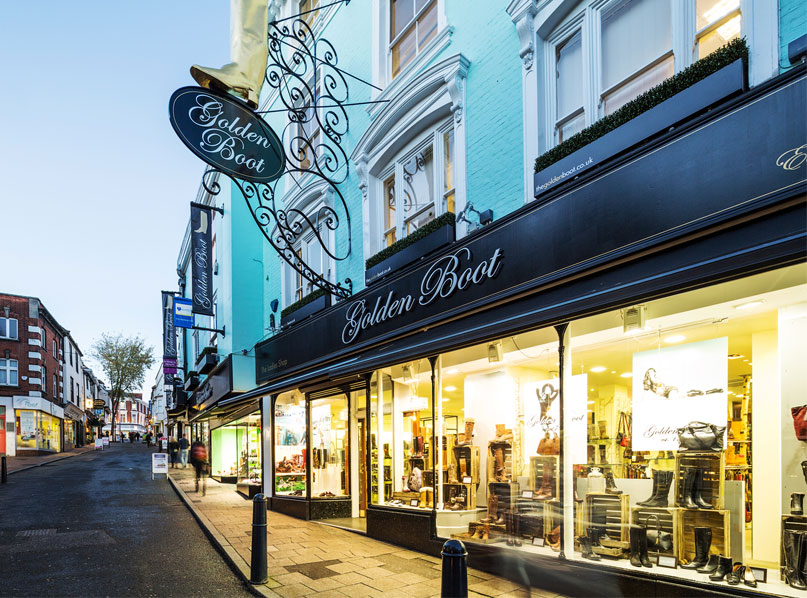
At the time of the Domesday Survey, Maidstone had six mills; at least one of these was probably on this site. Certainly until 1900 there were two mills here that originally served the Archbishops’ Palace. You can still see the ancient millpond formed by a dam on the River Len (next to Rootes garage).
Learn more about Maidstone’s mills on the historic panel located in Palace Avenue Cross Palace Avenue.
Originally named the ‘Tithe Barn’, this building was where visitors to the Archbishops’ Palace lodged their servants and horses. The stone work and buttresses may well be of the same date as All Saints Church (1397). Today the Archbishops’ stables are home to the Maidstone Carriage Museum, opened in 1946 by the eccentric Sir Garrard Tyrwhitt-Drake, 12 times Mayor of Maidstone. It houses his unique collection of horse-drawn vehicles, widely regarded as the finest in Europe.
Cross the road carefully then pause outside the Gatehouse. Here you will see a map by local artist Graham Clarke illustrating Maidstone’s historic town centre. There is also an historic panel giving more details on the development of the Archbishops’ Palace. Return to the crossing and follow the footpath along the main road. Stay on the path until you almost reach the main road bridge then take the steps down towards the river. Discover more about trade on the River Medway on the historic panel located just to the right of the steps. Head back towards the Archbishops’ Palace taking the footpath through the archway and into the Palace gardens.
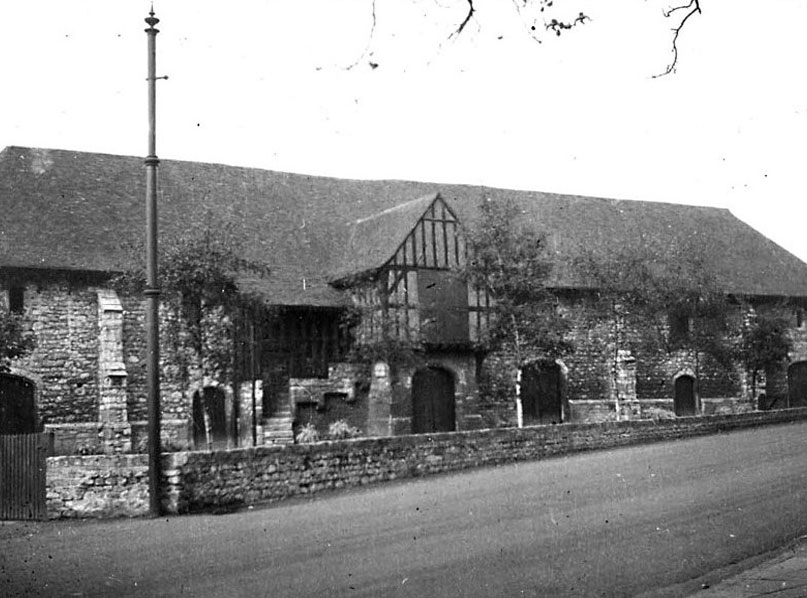
As Lords of the Manor, the Archbishops were responsible for maintaining law and order and had their own gaol at the Palace. Among its inmates was John Ball, the so-called ‘Mad Priest of Kent’, whose preachings infuriated the church hierarchy. Kent was one of the main centres of rebellion during the Peasants Revolt in 1381. Rebels, led by Wat Tyler, released John Ball before storming the Tower of London and beheading the Chancellor. Confronting King Richard II, Wat Tyler was stabbed and killed by the Mayor of London.
You can read more about the Peasants Revolt on the historic panel located in the Palace gardens. Take the footpath behind the Gatehouse and descend the steps.
From the foot of these steps you can see a 13th century stone bridge, one of the oldest structures in Maidstone, now preserved under the modern road junction.
Return to the Palace Gardens.
This site was described in the Domesday Survey as land held by the Archbishop of Canterbury at ‘Maddestane’. The medieval Palace has developed and changed since the Middle Ages, with parts being removed and rebuilt according to the needs of the time. King Henry VIII stayed here, appointing a Maidstone man as Royal Physician to treat his painful gout, and later expropriated the property for the Crown. It was bought by the people of Maidstone to mark Queen Victoria’s Golden Jubilee and is now used as a Register Office.
.jpg)
The Garden in the grounds of the Palace is an authentic medieval herb garden maintained by the Kent Garden Trust and may be visited by the public. Note the Dove of Peace statue.
Maidstone’s main parish church is built on the site of the 7th century Saxon church called St Mary’s, but was rebuilt in the 14th century by Archbishop Courtenay to become the ‘grandest Perpendicular Church in England’. Completed in 1398 it has remained largely unchanged, although it did formerly possess a wooden spire which was destroyed by lightning in 1730. Set into the south wall of the church is a 17th century memorial to local man Lawrence Washington, great-uncle to the famous George Washington. The memorial bears the Stars and Stripes of the Washington family, which were subsequently adopted in the flag of the United States of America.
Don’t miss the 15th century wall painting behind the choir stalls.
This building formed part of a complex of medieval architecture which remains one of the most complete and impressive in England. The College was built in 1395 by Archbishop Courtenay to house the priests attached to All Saints Church. This was an important spiritual and intellectual centre for the whole county in medieval times. King Henry VIII dissolved the College in 1546 and the property was much neglected until the late 17th century when it came into farming use. It is now leased as private offices.
Walk down the Horseway to the river’s edge. Here you will find another historic panel with more information on the church and College.
One of the largest projects in the South East to mark the new Millennium, Maidstone’s Millennium River Park opened up access to the River Medway along a 10km path from Teston to Allington. The award-winning Lockmeadow Millennium Bridge is one of the landmarks of the new park. The bridge occupies the site of a 14th century ford, once the main crossing point for the River Medway. On the opposite bank is Lockmeadow, home to Maidstone Market and The Stag. This 21ft tall aluminium sculpture was erected in London in 1963 and now forms part of the River Art project, which also includes the Dove of Peace and the Totem positioned alongside Maidstone’s central bridge.
Turn onto the riverside path, keeping the river on your left.
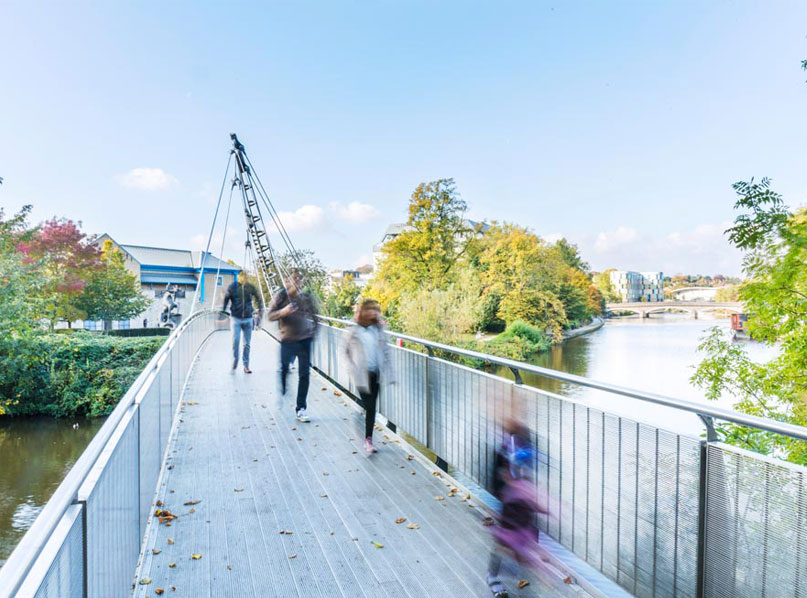
The riverside was once a hive of industry. Local ragstone was shipped down the River Medway to build the Roman wall of the City of London, and later the Tower of London. After 1739 upriver navigation was enhanced to enable Maidstone to trade with the whole of the Weald. River traffic was still considerable in 1900, but as roads improved river transport went into terminal decline. Today, the River Medway is used for recreation and visitors can enjoy the beautiful scenery on board a river boat.
Continue along the riverside path.
The first bridge to occupy this site was probably built in the 14th century to provide a more direct route to the commercial heart of the town than the ford located further upriver. It was one of a number of similar crossings constructed of local ragstone during medieval times at Aylesford, East Farleigh and Teston. The original bridge was finally declared unsafe in the 1870s. The current bridge was built in 1879 by Sir Joseph Bazelgette, the engineer responsible for the Thames Embankment and the London sewerage system.
Walk under the bridge.
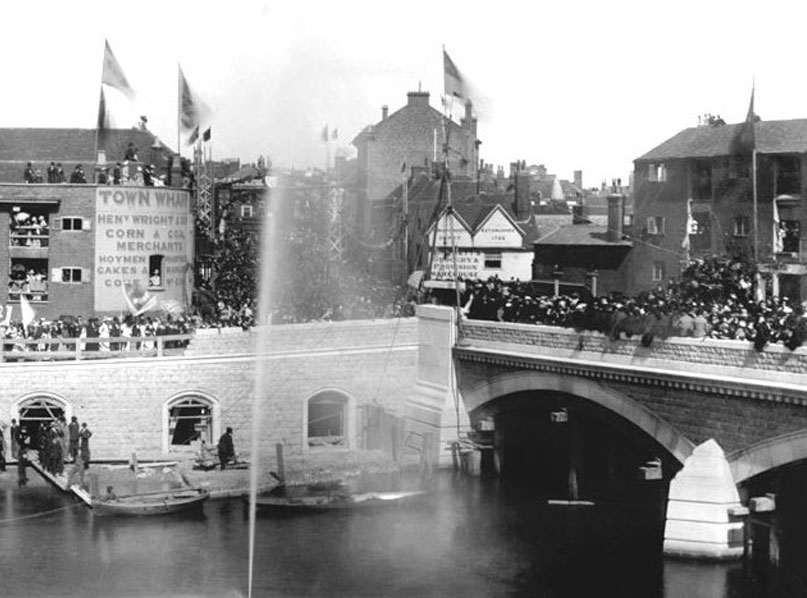
Fairmeadow became notorious during the persecution of Protestants by Queen Mary, when seven Protestant martyrs were burned at the stake here in June 1557. These executions may have accounted for the Puritan backlash in the town in succeeding decades. A tree-lined embankment was laid along the Medway in 1699, making Fairmeadow a fashionable place to stroll and providing one of the first public walks outside of London.
Read more about the Marian persecutions and the development of Fairmeadow on the historic panel here. Turn right and go through the underpass. Then turn left and walk towards the Fremlin Walk shopping centre.
This 14th century building was originally owned by the Corpus Christi Fraternity, a society of local tradesmen who regulated business, observed certain religious services and provided for elderly and infirm members. The Fraternity lasted until 1547 when it was dissolved by the crown during the suppression of religious guilds. The town then bought the hall and it served as Maidstone Grammar School from 1549-1871. It is now available for private hire.
Cross the road towards Fremlin Walk.
Fremlin Walk shopping centre is built on the site of the Fremlin brewery, owned by Ralph Fremlin, who, by 1861, was Kent’s largest brewer. Fremlin’s connections in East India were symbolised by his trademark elephants and weathervane, examples of which are on permanent display in the shopping centre.
Climb the steps under the arch and cross the shopping centre to return to Maidstone Museum and the Visitor Information Centre.
If you would like to request a copy of the Historic Walking Tour brochure please email info@visitmaidstone.gov.uk.
© Visit Maidstone 2025. All Rights Reserved



